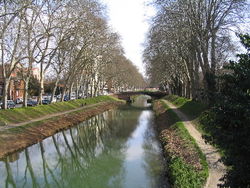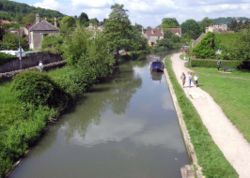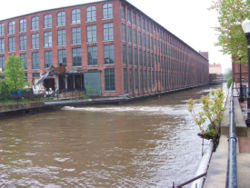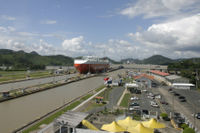Canal
2007 Schools Wikipedia Selection. Related subjects: Engineering


Canals are man-made waterways, usually connecting existing lakes, rivers, or oceans. There are two main types of canals: irrigation canals for the delivery of water and transportation canals for passage of goods and people. Some rivers have also been canalised to make them navigable.
Smaller transportation canals can carry barges or narrowboats, while ship canals can accommodate sea-going ships and may connect one ocean to another.
Ancient canals
The oldest-known canals were built in Mesopotamia circa 4000 BC. The Indus Valley Civilization in Pakistan and North India (from circa 2600 BC) had the first canal irrigation system in the world. The longest canal of ancient times was the Grand Canal of China. It is 1794 kilometers (1115 miles) long and was built to carry the Emperor Yang Guang between Beijing and Hangzhou. The project began in 605, although the oldest sections of the canal may have existed since circa 486 BC. In places it is 30 m (100 ft) wide.
Cities on water
Canals are so deeply identified with Venice that many canal cities have been nicknamed "the Venice of..." The city is built on marshy islands, with wooden piles supporting the buildings, so that here it is not so much the waterways which are man-made, as the land. The islands have a long history of settlement, and by the 12th century Venice was a powerful city state.
Amsterdam was built in a similar way, with buildings on wooden piles. The pace of draining of fenland and polder in the Low Countries quickened in the 14th century and canalization made the village of Amsterdam a port. It became a city around 1300.
Industrial revolution


In Europe and then in the young United States, inland canals preceded the development of railroads during the earliest phase of the Industrial Revolution; some canals were later drained and used as railroad rights-of-way. Navigable canals reached into previously isolated areas and brought them in touch with the world economy. The Erie Canal, for instance, opened up a connection from the populated Northeast to the fertile Great Plains.
The oldest canal built for industrial purposes in North America is Mother Brook in Dedham, MA. It was constructed in 1639 to provide water power for mills. Lowell, Massachusetts, considered to be "The Cradle of the American Industrial Revolution," has 6 miles of canals that provided waterpower and a means of transportation for the city.
Competition from the railway network made many canals obsolete for commercial transportation, and many fell into decay.
Modern uses

A movement that began in Britain and France to use the picturesque early industrial canals for pleasure boats has spurred rehabilitation of stretches of historic canals.
Canals have found another use in the 21st century, as wayleaves for fibre optic telecommunications networks.
Famous canals and lists

- List of waterways
- Grand Canal of China - Longest Canal
- Lingqu Canal - the oldest existing canal in the world
- Birmingham Canal Navigations- UK
- Birmingham and Fazeley Canal - UK
- Canals of Ireland
- List of canals in the United States
- Canals of the United Kingdom
- Klong
- Suez Canal
- Panama Canal
- Corinth Canal
- Cape Coral, Florida
- Venice
- Amsterdam
- Saimaa Canal - Lappeenranta, Finland
- White Sea-Baltic Canal, Russia
- Welland Canal - Ontario, Canada
- Saint Lawrence Seaway - Quebec, Ontario, Canada
- Erie Canal - New York, U.S.
- C & O Canal - U.S.
- Rideau Canal - Ontario, Canada
- Shubie Canal - Nova Scotia, Canada
- Lachine Canal - Montreal, Quebec, Canada
- Manchester Ship Canal

